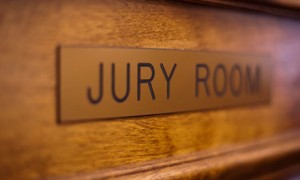The DeBour Standard: Common Law Right of Inquiry, And Meaningful Response To Notes From The Jury
People v Parker
2018 NY Slip Op 04776
New York Court of Appeals
Decided: June 28, 2018
ISSUE:
ONE Whether the police had a founded suspicion of criminal activity to support a common-law right of inquiry, pursuant to the Fourth Amendment, where two defendants were the only people observed at the scene of a reported crime, and defendants twice refused to interact with the police then fled in opposite directions. TWO Whether the reading of jury note in a series of notes on record is sufficient in satisfying the core obligation of the trial court under CPL 310.30 where the court acknowledged the receipt of three jury notes, read the first note on record and failed to read the other two notes prior to the jury reaching a verdict.
HOLDING:
ONE The Court held that the police had founded suspicion of criminal activity to support a common-law right of inquiry where the encounter with the defendants at the scene of a reported crime took place only five minutes after the crime was reported and was followed by the defendants’ refusal to respond to police questioning and the defendants’ flight.
TWO The Court held that an insufficient record couldn’t be overcome with speculation of what might have occurred. In this case, the record failed to establish that the trial court provided notice of the specific contents of two substantive jury notes and thus did not discharge them of a core obligation. CPL 310.30 requires that for each jury note, the trial court must provide a meaningful notice of the contents to counsel and the court must in return provide the jury with a meaningful response.
FACTS OF THE CASE:
On the morning of January 21st, 2008, police officers received a radio transmission about a burglary in progress. Within five minutes, three squad cars arrived at a country club in a residential neighborhood, the address was provided by the 911 caller. The scene was empty except for the two defendants, who were exiting the club via its private driveway toward the street. Uniformed officers approached the driveway, badges displayed, and ordered the defendants to stop. One of the officers stated “we’re police officers and wanted to ask you a question,” to which the defendants ignored as they continued walking to the street. Again, the officer called out “please, stop, we want to ask you a question,” to which defendants took off in opposite directions away from the police.
Defendant Nonni took off running while defendant Parker “briskly walked” in a “hurried pace” and “evasive manner” in the opposite direction from Nonni. Eventually, they caught up with Nonni, subdued him and handcuffed him. While handcuffing him, a knife sliced through Nonni’s left back pocket and cut the officer’s finger. Subsequently, the officers searched Nonni’s bag and found two other knives as well as a roll of duct tape. Additionally, they retrieved three bank envelopes, “each marked with orange highlighter and each containing $1000” in the left back pocket. Meanwhile, the other two officers followed Parker, telling him to stop. As officers got closer, they noticed a sledgehammer in Parker’s unzipped backpack. When the officers eventually caught up to Parker, they grabbed him from behind and handcuffed him, retrieving a crowbar from his backpack and a steak knife from the front pocket of his coat.
During the jury deliberations, the jury sent out three substantive notes to the court within an hour. The notes were marked into evidence as court exhibits. The court stated on the record, outside of the jury’s presence, that it had received all three notes and would read them into record as soon as the jury was seated; the court announced that it would get through a least one note at that time. The court proceeded, believing counsel agreed upon the sections of the testimony that would be read to the jury in response to the first note. At the time, the court did not read the other notes into the record nor mention whether counsel had seen or discussed these notes.
When the jury returned to the courtroom, the court stated on the record that it had received three notes and would read them back. The court then read the first note and proceeded to read back the requested testimony. At the conclusion of the readback, the court stated, “the additional testimony that you requested in the other two notes, we’ll respond to after lunch.” After the break, the court announced on the record that the jury had sent a note indicating it had reached a verdict. In response to the court’s inquiry, defense counsel and prosecutor confirmed they had seen this last note. The court then accepted the verdict on the record in open court.
ANALYSIS:
Mixed Question of Law and Fact
“As a threshold matter, whether the particular circumstances of defendant’ cases give rise to a founded or reasonable suspicion constitutes a mixed question of law and fact, which is beyond our review if there is record support for the courts’ conclusion that the officers’ actions were justified” People v McRay, 51 NY2d 594, 601. A mixed question of law and fact is present where facts are disputed, where credibility is at issue or where reasonable minds may differ as to the inference to be drawn from the established facts.” NY Const, art VI.
The Court of Appeals found that flight alone does not justify a common law right of inquiry on a forcible stop. However, combined with “other circumstances indicating that the suspect may be engaged in criminal activity makes police intrusion permissible. In this case, the encounter the officers had with the defendants just five minutes after receiving a radio transmission of a burglary in progress combined with no other persons or cars at the scene of the crime was in accordance with the four-tiered framework established in People v. De Bour (40 NY2d at 223). The levels of the four-tiered framework are as follows: 1) the right to request information 2) the common right law of inquiry 3) a forcible stop and detention 4) probable cause to arrest.
The aforementioned suspicious circumstances were enough for the police to engage in the first level 1) The Right to Request Information, or “minimally-intrusive questioning,” such as what they were doing there and where they were going. Following, they were able to begin the second level 2) The Common Right Law of inquiry, which permitted the officers “to gain explanatory information… short of forcible seizure” upon a “founded suspicion that criminal activity is afoot.” Once defendant Nonni ran or “actively fled from the police,” the officers were permitted to engage in the third level 3) A Forcible Stop and Detention, which requires that the “officer entertain a reasonable suspicion that a particular person has committed, is committing or is about to commit a felony or misdemeanor,” and “a corollary of the statutory right to temporarily detain for questioning is the authority to frisk if the officer reasonably suspects that they are in danger of physical injury by virtue of the detainee being armed,”
This flight combined with the other circumstances was considered adequate support that there was a reasonable suspicion of criminal activity to justify defendant Nonni’s pursuit, forcible stop and detainment. Defendant Parker argued that he “briskly walked away” as opposed to ran away. However, police officers observed that when Parker saw Nonni run and police officers chase him, defendant Parker proceeded to increase his own pace, crossed the street onto another property and acted in an evasive manner. Active avoidance of confrontation with the police, like flight, does not justify reasonable suspicion but, combined with the highly suspicious conditions observed by the officers could give rise to heightened suspicion. Therefore, there was record support for the court’s conclusion that the officers had reasonable suspicion, and that the pursuit, stop and detainment of Parker were permissible.
Finally, the courts found that the officers were allowed to engage in the fourth level 4) Probable Cause to Arrest, where the officer must have “probable cause to believe that person has committed a crime or offense in the officers’ presence” in order to arrest. The moment Nonni was handcuffed and a knife inside his backpack cut the officer’s finger, the searching of Nonni’s person and belongings was “justified and lawful.” With defendant Parker, seizure of his person and belongings was “justified and lawful” when the officers were close enough to see the sledgehammer peeking out of his open backpack.
Reading of Jury Notes
The Court of Appeals decided that an inadequate record cannot be overcome with speculation of what might have occurred. It was concluded that where a record “does not establish compliance with 310.30, the sole remedy is reversal and a new trial.” CPL 310.30 requires that, in responses to a jury request for additional information or instruction “with respect to any matter pertinent to the jury’s consideration of the case,” the trial court “must direct that the jury be returned to the courtroom and, after notice to both the people and counsel for the defendant, must give such requested information or instruction as the court deems proper” To simplify, the court has two main duties upon receipt of a substantive note from a deliberating jury: “the court must provide counsel with meaningful notice of the content of the note, and the court must provide a meaningful response to the jury” (27 NY3d 534, 536 [2016], citing O’Rama, 78 NY2d at 276-277). Meaningful notice is further defined as a notice containing the actual, precise content of the jurors’ request.
Additionally, the courts must provide counsel with meaningful notice and the jury with a meaningful response for each and every note. In this case, there is no record showing that counsel was informed of the exact contents of the two subsequent notes which connotes a failure of the court to meet their obligation under O’Rama (78 NY2d 270 [1991]). In order to properly establish, on the record, that counsel was notified of the existence of a note there must be “indication that the entire contents of the note were shared with counsel.” It is irrelevant that a court demonstrates that they’ve shown counsel prior jury notes because specific, record proof that the court did so for each note is required. “The record… must indicate compliance with adequate procedures under O’Rama because reviewing courts cannot assume that the proper procedure was utilized when the record is devoid of information as to how jury notes were handled.”



